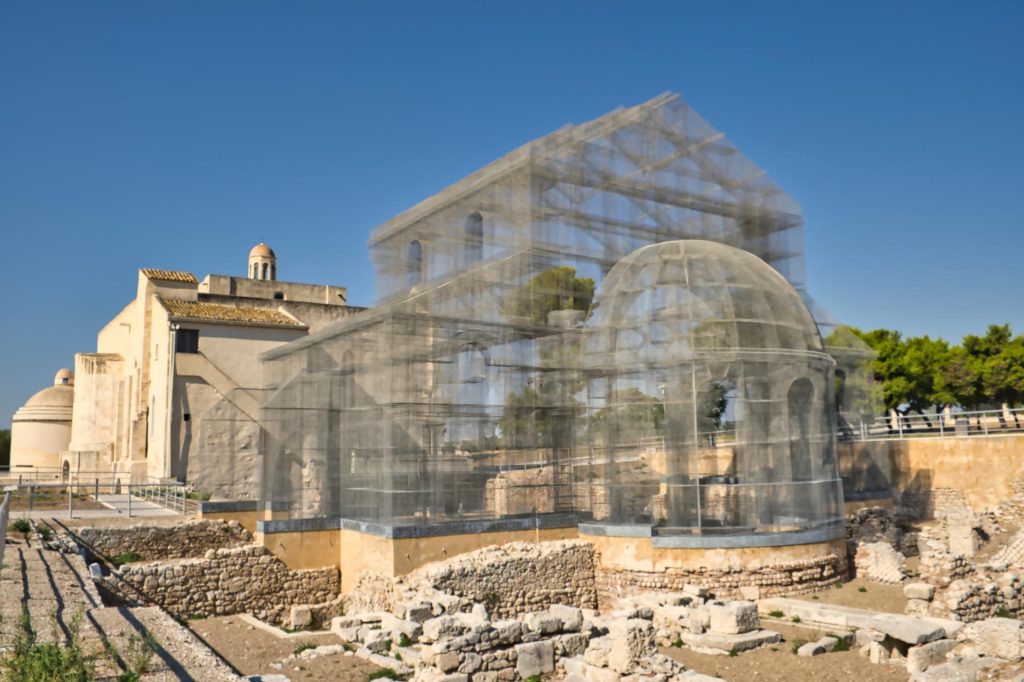
- Home
- Industries
- Architecture
Wire Mesh in the Architecture Industry
Wire mesh has the ability to offer unique designs while still offering structural integrity for a project. From facades and ceiling panels to interior design elements and railing infill panels, wire mesh products represent a very valuable tool for architects looking for aesthetically pleasing materials that have durability and corrosion resistance both indoors and outdoors.
At Ferrier Wire, we provide architectural mesh in perforated, woven, and expanded varieties. Our extensive range of design wire mesh options offers architects flexibility in making their vision a reality.

Applications of Wire Mesh in Architecture
Decorative Facades
Architectural woven wire mesh is widely used as infill panels to enhance both aesthetic appeal and strength of railings, ceilings, and privacy screens. Wire mesh offers architects a wide range of design options, including different patterns, textures and finishes to create visually stunning elements that stand out.
On top of the aesthetic benefits, architectural wire mesh panels can help regulate sunlight penetration into the buildings, reducing glare and heat gain while still allowing natural light to shine through. By optimizing sunlight management, wire mesh panels reduce the need for artificial lighting and air conditioning, thus improving energy efficiency.
Interior Elements
Wire mesh is commonly integrated into interior design elements to add both functionality and aesthetic appeal to spaces. Ferrier Wire works with various clients who specialize in carpentry and millwork, providing custom sized panels to be used in projects.
More specifically, many of our design woven and design perforated products are utilized in cabinetry as infill panels due to the open area and variety of designs Ferrier Wire can offer. Wire mesh partitions offer a modern and airy alternative to traditional solid partitions, providing visual separation while maintaining a sense of openness in an interior space. Other interior applications include wire mesh ceilings, railings, wall panels and more.
Functional Uses
In addition to its decorative uses, wire mesh also provides a durable, corrosion resistant solution that is able to withstand the elements in both indoor and outdoor environments.
Structural Reinforcement
Welded wire mesh panels are often used as reinforcement material in concrete and masonry due to it’s large wire diameters and high percentage of open area. This provides tensile strength and structural stability to building elements like walls, floors and pavements.
Safety Features
Building components such as balustrades, guardrails and safety barriers can all incorporate wire mesh to improve safety and comply with building codes and regulations.
Ventilation and Screening
Architectural metal mesh screens and grills are used for ventilation, airflow control and screening purposes in building facades and HVAC systems to ensure proper ventilation and protection against external elements.
Types of Wire Mesh Used in Architecture
In architecture, many types of wire mesh are used for different design and functional purposes. While numerous options exist, the following are some of the most commonly used types:
Woven Wire Mesh
Woven wire mesh is created by interlacing metal wires in various patterns, providing a flexible yet strong material ideal for decorative and structural applications. This type of mesh can be customized in terms of aperture size, wire diameter, and material, allowing architects to achieve specific visual effects and functional requirements.
Welded Wire Mesh
Made by welding intersecting wires at their junctions, creating a rigid and durable mesh commonly used for applications requiring highly strong and stable material, such as railings, fences, and building facades. The welding process provides a clean, smooth surface that can be easily coated or painted to suit different architectural styles.
Expanded Metal Mesh
Expanded metal mesh is manufactured by cutting and extending metal sheets, creating a diamond-shaped pattern. This type of mesh is known for being strong, lightweight, and versatile, making it suitable for facades, ceilings, and cladding. Expanded metal mesh provides excellent ventilation and visibility while offering an elegant architectural appearance.

Benefits of Using Wire Mesh in Architecture
Wire mesh offers architects the flexibility to create intricate patterns, textures, and forms that can complement projects. These products are lightweight yet durable, making them suitable for applications requiring strength and stability in harsh environmental conditions. Additionally, wire mesh effectively diffuses natural light while maintaining privacy and offering natural ventilation, contributing to energy efficiency.
Partner With Ferrier Wire for Your Next Design
Architectural wire mesh is a versatile and durable material that can enhance both the functionality and aesthetics of a building. Ferrier Wire offers custom shearing as well as finishing options to tailor our wire mesh solutions to our client’s precise needs. Whether clients require a specific mesh size, material type, or weave pattern, our team will work closely with you to create a customized solution.
Ferrier Wire carries a wide variety of design weavemesh available in brass, bronze, copper, stainless steel, mild steel, and even galvanized steel with some of our patterns being woven in house. Ferrier Wire also stocks many design perforated patterns mostly available in mild steel. It is worth noting that mild steel specifically will rust over time if it is left unfinished. For the majority of our products, we can provide mill test reports, certificates of conformance, and certification of the country of origin.
Contact Ferrier Wire today to learn more about our architectural wire mesh products and how we can meet your project needs.
We are here for you!
Whether you have questions, need details, or want support
for your project, we’re here to help!

170 Mulock Avenue Toronto, Ontario, M6N 3C8
Mon-Thurs 8:00 am - 4:00 pm Fri 8:00 am - noon
Shipping and receiving closed 12:30 pm - 1:00 pm
- Projects
- Air Canada Centre
- Spa privacy screen
- Sports and Country Bar
- Ottawa Art Gallery Railing
- Peter Powning's Light Spirals
- Black PVC Wildlife Barrier
- Union Station
- Aalto Grocery Store Signage
- Stoa Design Collective - Fleet's Foods
- Nightingale Restaurant
- Nathan Phillips Square
- Kelvin Kellman Architecture Boutique Shoe Salon
- Kilogram Studio Juice Bar
- Tennis Player
- Liz Pead
- Architect@Work
- Olena Kassian Sculpture
© 2025 Wire Mesh Supplier - ferrierwire.com. All Rights Reserved.
Powered by TechWyse
Stay up to date by subscribing to our newsletter.
